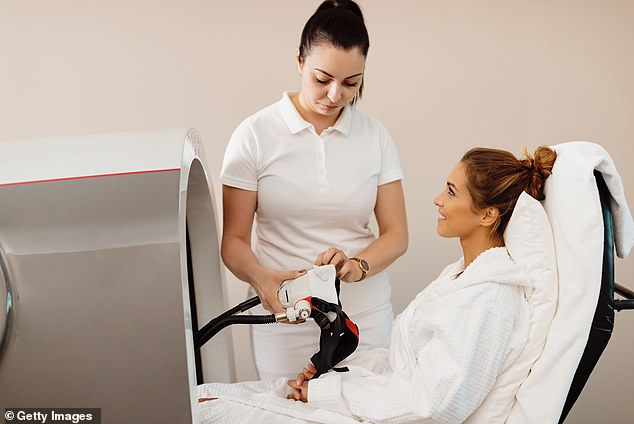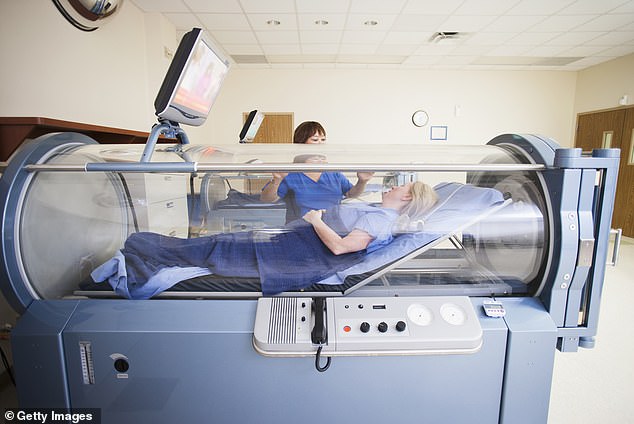New hope for endometriosis: A revolutionary treatment that scientists think could help patients – without drugs
Breathing oxygen under pressure – the equivalent of being 45 ft under the sea – is being tested as a new treatment for endometriosis.
The painful condition, where tissue similar to the lining of the womb is found elsewhere in the body, is estimated to affect around 1.5 million women in the UK.
In a new clinical trial, patients will sit in a diving chamber for 90 minutes at a time, five days a week for eight weeks, breathing pure oxygen.
The idea is that the treatment will reduce the inflammation that plays an important role in the development of the condition.

In a room, like the one above, patients will breathe 100% oxygen (room air contains 21 percent oxygen)

The women will stay in a hyperbaric chamber for 90 minutes at a time, five days a week for eight weeks, breathing pure oxygen.
In endometriosis, cells similar to those in the uterus grow anywhere, usually on or near the reproductive organs in the pelvis or abdomen, including the fallopian tubes and ovaries. In some women, they can grow and surround the bladder, cervix, colon and other areas.
Like the lining of the uterus, these endometrial tissue fragments break down and bleed over time, but they cannot leave the body.
Accumulation of abnormal cells can cause swelling, cysts and scars. Bands of fibrous tissue called adhesions may also form, causing pelvic tissues and organs to stick together.
Symptoms include severe pain and extreme fatigue: endometriosis is also one of the most common conditions associated with female infertility.
There is currently no cure: treatments range from painkillers to hormone therapy – taking birth control pills, for example, to stop the growth of endometrial cells and prevent ovulation (reducing pain associated with endometriosis).

There is no cure for endometriosis. Modern treatments include painkillers and even ancient aids such as hot water bottles
Some women have surgery to remove the endometrial lining – it is estimated that this will happen again in 20 to 30 percent of cases. In a new trial at Sunnybrook Health Sciences Center and Hospital in Toronto, Canada, 64 women aged 18 and over will have standard treatments, including painkillers, and half will also have hyperbaric therapy. Inside the room, patients will breathe 100% oxygen (room air contains 21% oxygen).
High atmospheric pressure increases the amount of oxygen entering the blood and tissues, and hyperbaric chambers – which were originally designed to treat bends, or decompression sickness, in different species – are now used to treat the number increasing conditions, including burning. , carbon monoxide poisoning and wounds.
Scientists in a new experiment in mice have suggested that inflammation and low oxygen levels are linked to the development of endometriosis and its symptoms.
And a 2022 study published in the International Journal of Reproductive BioMedicine found that mice with endometriosis can be successfully treated with hyperbaric therapy.
Dr Ahmed Ismail, a gynecologist and obstetrician at the Queens Clinic, Harley Street, London, said the new treatment shows some potential to reduce inflammation and possibly reduce symptoms in small studies.
However he adds: ‘the risks and complications associated with prolonged exposure to oxygen, as well as the limited scientific evidence, suggest that this treatment should not be rushed.
‘Further research is needed before recommending HBOT as a standard treatment for women with endometriosis.’
#hope #endometriosis #revolutionary #treatment #scientists #patients #drugs